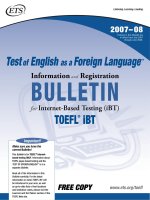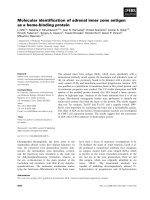Roles of RUNX3 as a tumor supressor protein
Bạn đang xem bản rút gọn của tài liệu. Xem và tải ngay bản đầy đủ của tài liệu tại đây (4.54 MB, 248 trang )
ROLES OF RUNX3 AS A TUMOUR SUPPRESSOR PROTEIN
LEE WEI LIN
BSc (Hons), NUS
NATIONAL UNIVERSITY OF SINGAPORE
2008
ROLES OF RUNX3 AS A TUMOUR SUPPRESSOR PROTEIN
LEE WEI LIN
BSc (Hons), NUS
A THESIS SUBMITTED
FOR THE DEGREE OF DOCTOR OF PHILOSOPHY
NUS Graduate School for Integrative Sciences and Engineering
NATIONAL UNIVERSITY OF SINGAPORE
2008
Acknowledgements
“Science can only determine what is, but not what shall be, and beyond its realm, value
judgements remain indispensable”
Albert Einstein
Research is a constant pursuit of knowledge, of trying to unravel answers to a
never-ending stream of questions. In this pursuit of knowledge, there are no easy answers
and the importance of good supervisors to learn from and a proper conducive research
environment cannot be undermined.
None of the work described in this thesis would have been possible without the
help and support of a large number of people who have been a part of my graduate
education, as friends, mentors and colleagues. Although many have come and gone, they
have each played a significant role at various stages of my graduate pursuit.
First and foremost, I would like to express my deepest gratitude to Professor
Yoshiaki Ito for being my PhD supervisor. I am very thankful for his guidance and
honoured to have had the opportunity to be part of his laboratory the past four years. I am
grateful to have been able to learn from him. His depth of knowledge and vast wisdom is
a constant inspiration and motivation. In addition, I am also appreciative of his continued
encouragement and helpful suggestions.
I am deeply grateful to Dr Kosei Ito, for guiding me through my thesis project the
past two and a half years, and for his invaluable guidance, supervision, understanding and
patience throughout the course of the project. I am grateful to him for imparting his
knowledge and wisdom to me, guiding me along this difficult journey. I would also like
i
to say a big thank you to Dr Yasuko Yamamura, who taught me the basic research skills
and techniques, which laid the foundation for my thesis project.
A special word of thanks to Dr Hiroshi Ida, who taught me the basics of real-time
PCR, which eventually became my favourite technique. In addition, I would also like to
thank all the members of the RUNX research group, past and present, both from IMCB
and ORI. It has been wonderful working in this lab, and it wouldn’t have been the same
without each and every one of you. In particular, I am grateful to Dr Anthony Lim , Dr
Linda Chuang, Dr Dominic Voon and Dr Hiroyuki Kato for providing timely and
constructive comments and suggestions.
I would like to thank A*STAR for the award of the A*STAR Graduate
Scholarship, which has supported me to do the work described in this thesis. In addition,
I would also like to say a big thank you to all the staff of the NGS department in NUS,
especially to Gloria, Ivy and Madeline, for their administrative support, friendship and
encouragement the past few years.
I am blessed to have the friendship of my classmates from NGS, good friends
from Fairfield Methodist Primary and Secondary School and Faith Methodist Church,
who have always been there for me and kept me sane. In addition, I thank God for two of
my buddies from ORI, Ti Ling and Michelle, who shared laughter, tears and joy with me
in ORI. Lastly, thank you to all my Sunday school kids from Faith Methodist Church
who have, in their special way, been my source of joy.
Finally I would like to express my greatest and deepest gratitude to my family -
my fiancé, Wei Jie, who has always been there for me through all my ups and downs; my
beloved and charming brother, Wei Kit, who is the best brother anyone could ever ask
ii
for; my beloved mum and dad, for their immense encouragement and unwavering
support. They raised me, taught me, supported me, inspired me, loved me, provided me
with the best education and moulded me into the person I am today. To them, I dedicate
this thesis.
iii
Table of Contents
Acknowledgements i
Table of Contents iv
Summary vii
List of Tables ix
List of Figures x
List of Abbreviations xii
Chapter 1: Introduction 1
1.1 Prologue 2
1.2 History and Discovery of RUNX 3
1.3 Evolutionary conservation of RUNX genes 5
1.4 The Runt domain transcription factor, PEBP2/CBF 6
1.5 RUNX1, 2, 3 8
1.6 Gain or loss of RUNX genes in cancer 11
1.7 RUNX3 as a tumour suppressor 13
1.7.1 Role of RUNX3 in the TGF-β pathway 13
1.7.2 RUNX3 and the chromosomal locus 1p36 21
1.7.3 Other evidences 22
1.8 Knockout phenotype of RUNX3 25
1.9 Biology of the intestinal epithelium 27
1.10 Intestinal neoplasia – colorectal cancer 30
1.11 Signalling pathways involved in intestinal development 31
and cancer
1.11.1 Wnt signalling 32
1.11.2 TGF-β signalling 38
1.11.3 BMP signalling 41
1.12 Interaction between BMP and Wnt signalling pathways 50
in colorectal cancer
Chapter 2: Results 56
2.1 Characterization of colorectal cancer cell lines 57
2.1.1 Gene expression profile of BMP receptor and 57
components of BMP signalling pathway
2.1.2 Gene expression profile of members of 60
RUNX family
2.1.3 Protein expression profile of members of 62
RUNX family
2.1.4 Immunofluorescence analysis of endogenous 63
RUNX3 in colorectal cancer cell lines
iv
2.2 BMP-SMAD signalling is intact in HT-29 colon cancer cells 65
2.3 Growth suppressive effect of BMP 67
2.4 Growth suppression by BMP is not mediated by apoptosis 70
2.5 Growth suppression by BMP is not mediated by p21
CIP1/WAF1
71
2.6 BMP treatment enhances RUNX3 expression in HT-29 cells 72
2.7 RUNX3 negatively regulates Wnt signalling and forms a 77
ternary complex with β-catenin and TCF4
2.8 RUNX3 attenuates the transactivational potential of 83
β-catenin/TCF4 in Wnt signalling
2.9 RUNX3 attenuates the DNA binding activity of β-catenin/TCF4 85
2.10 BMP treatment represses c-Myc expression 88
2.11 BMP targets c-Myc expression by transcriptional mechanisms 89
2.12 BMP attenuates the transcriptional potential of β-catenin/TCF4 95
in Wnt signalling
2.13 Mutations in RUNX- and TCF- binding elements abrogate 96
BMP-mediated repression of c-Myc promoter activity
2.14 BMP reduces the DNA-binding ability of β-catenin/TCF4 101
on the c-Myc promoter
2.15 RUNX3 expression plays a role in growth suppression 103
by BMP
2.16 Summary 116
Chapter 3: Discussion 118
Chapter 4: Conclusion and Perspectives 157
Chapter 5: Materials and Methods 161
5.1 Cell culture and cell lines 162
5.2 Recombinant proteins 162
5.3 Transfections 162
5.4 Lentiviral Infection 164
5.5 Promoter studies 165
5.6 Site-directed mutagenesis 166
5.7 RNA isolation and reverse transcription 167
5.8 Real-time PCR analysis 168
5.9 Preparation of nuclear and cytoplasmic extracts 168
5.10 Western Blot analysis 169
5.11 Immunoprecipitation 170
5.12 Immunofluorescence 171
v
5.13 Measurement of cell proliferation 171
5.14 Apoptosis detection 171
5.15 Chromatin Immunoprecipitation (ChIP) assay 172
5.15 Statistical analysis 174
Bibliography 175
Appendices 215
vi
Summary
Bone Morphogenetic Protein (BMPs), a member of the Transforming Growth
Factor-β (TGF-β) superfamily, are multifunctional cytokines which regulate a broad
spectrum of biological functions including development, morphogenesis, proliferation,
differentiation and apoptosis. There is growing evidence that aberrations in BMP
signalling play an important role in intestinal cancer pathogenesis. Recent studies show
the presence of BMP receptor 1a mutations in juvenile polyposis and frequent Smad4
mutations in colon cancer. However, the exact molecular mechanisms remain poorly
understood.
The Runt domain transcription factor, RUNX3, is an integral component of
signalling pathways mediated by both the TGF-β and BMPs in various biological
systems. RUNX3 has been shown to be a gastric tumour suppressor, functioning
downstream of TGF-β pathway. Recently we demonstrated the tumour suppressive
effects of RUNX3 by its ability to attenuate β-catenin/TCFs transactivation in intestinal
tumorigenesis. The objective of this study is to explore the molecular basis of the tumour
suppressive function of the BMP pathway through RUNX3 in colorectal carcinogenesis.
I observed that BMP2/4 exerted a growth suppressive effect in HT-29, a human
colorectal cancer cell line, which retains an intact BMP signalling pathway. c-Myc, a
well-known oncogene in colorectal cancers and a target of the Wnt signalling pathway,
was found to be down-regulated by BMP2/4 and/or RUNX3 in HT-29. Evidence
obtained by this study suggests that up-regulation of RUNX3 by BMP reduces c-Myc
expression. A mutational analysis of the human c-Myc promoter showed that RUNX3
reduces the promoter activity through RUNX- and TCF-consensus sites. Taken together,
vii
these results suggest that RUNX3 down-regulates c-Myc expression directly at the
transcriptional level, and through attenuation of β-catenin/TCFs, downstream of BMPs in
colorectal epithelial cells.
viii
List of Tables
Table 2.1 Expression of BMP signalling pathway components in
colorectal cancer cell lines
59
Table 2.2 Expression of RUNX genes in colorectal cancer cells lines
61
ix
List of Figures
Figure 1.1 Crystal structure of the Runt domain heterodimerized with
PEBP2β bound to DNA
8
Figure 1.2 A diagrammatic representation of Drosophila Runt, RUNX1,
RUNX2 and RUNX3
9
Figure 1.3 TGF-β signalling pathway
13
Figure 1.4 Tissue anatomy of the adult small intestine
28
Figure 1.5 Tissue anatomy of the colonic epithelium
30
Figure 1.6 A model for the canonical Wnt signalling pathway
35
Figure 1.7 BMP signaling pathway
43
Figure 1.8 A model depicting the differential locations of active BMP
and Wnt signalling along the colon crypt axis of human
colon intestinal epithelial cells
51
Figure 1.9 The intestinal histopathology of noggin-transgenic mice
resembles that of humans with juvenile polyposis
53
Figure 2.1 Expression of RUNX proteins in 22 colorectal cancer cells
lines
62
Figure 2.2 Differential staining pattern of RUNX3 in human colorectal
cancer cell lines
63
Figure 2.3 BMP2 and BMP4 induce the phosphorylation and nuclear
accumulation of Smad1/5 in HT-29 cells
66
Figure 2.4 Growth-suppressive effect of BMP2/BMP4 on HT-29 cells
68-69
Figure 2.5 Effect of BMP on apoptosis in HT-29 cells
70
Figure 2.6
BMP2/BMP4 does not affect p21
CIP1/WAF1
expression 72
Figure 2.7 BMP2/BMP4 increases RUNX3 expression
74
Figure 2.8 BMP2/BMP4 does not affect RUNX1 and RUNX2 expression
75
x
Figure 2.9 TGF-β does not affect RUNX1, RUNX2 and RUNX3
expression
76-77
Figure 2.10 Expression of Wnt targets in wild-type and Runx3
-/-
intestine
79
Figure 2.11 Detection of a β-catenin/TCF4/RUNX3 ternary complex
81-82
Figure 2.12 RUNX3 represses the TOP reporter activity in HT-29 cells
84
Figure 2.13 RUNX3 attenuates the DNA binding activity of β-
catenin/TCF4
86-87
Figure 2.14 BMP2/BMP4 represses c-Myc expression
89
Figure 2.15 RUNX- and TCF-binding elements in the human c-Myc
promoter
90-91
Figure 2.16 Luciferase reporter assays using the human wild-type c-Myc
promoter
94
Figure 2.17 BMP2/BMP4 represses the TOP reporter activity in HT-29
cells
96
Figure 2.18 Mutational analysis of the human c-Myc promoter
99-100
Figure 2.19 ChIP assays demonstrate interaction of β-catenin with the c-
Myc promoter region containing TCF-binding sites
103
Figure 2.20 Suppression of RUNX3 expression level by RUNX3-siRNA
rescues BMP-induced c-Myc suppression
109-112
Figure 2.21 Suppression of RUNX3 expression level by RUNX3-shRNA
rescues BMP-induced c-Myc suppression
113-115
Figure 2.22 Working model: BMP regulation of c-Myc expression by
RUNX3 in colorectal cancer.
117
xi
List of Abbreviations
ALK Activin receptor-like kinase
APC adenomatous polyposis coli
Bim Bcl-2 homology domain-only factor
bHLH basic helix-loop-helix
BMP bone morphogenetic protein
CBF core binding factor
Cdks cyclin-dependent kinases
cDNA complementary DNA
ChIP chromatin immunoprecipitation
CK1 caseine kinase 1
DAPI 4’, 6-diamindino-2-phenylindole
DAPK Death-associated protein kinase
Dhs Dishevelled
Dkk Dickkopf
DMEM Dulbecco’s Modified Eagle’s Medium
DRG Dorsal Root Ganglion
EC Embryonic carcinoma
EGFP enhanced green fluorescent protein
ERK extracellular signal-regulated kinase
FACS fluorescence-activated cell sorting
FAP Familial adenomatous polyposis coli
FBS Fetal Bovine Serum
FITC fluorescein isothiocyanate
Fz Frizzled
GADD Growth Arrest & DNA Damage
GFP green fluorescent protein
GAPDH Glyceraldehyde-3-phosphate dehydrogenase
GSK Glycogen syntahse kinase
H&E Hematoxylin and eosin
HDAC histone deacetylases
HNPCC hereditary nonpolyposis colorectal cancer
JNK c-jun-N-terminal kinase
JP Juvenile Polyposis
LOH Loss of heterozygosity
LRP Low-density lipoprotein receptor-related family
MAPK Mitogen-activated protein kinase
MH Mad-homology
MKK4 mitogen-activated protein kinase kinase 4
MoMLV Moloney murine leukaemia virus
mRNA messenger RNA
NLK nemo-like kinase
PBS Phosphate-Buffered Saline
PBS-T Phosphate-Buffered Saline-Tween20
PCR Polymerase Chain Reaction
xii
xiii
PEBP2 Polyomavirus enhancer-binding protein 2
PI Propidium Iodide
PI3-K phosphatidylinositol 3-kinase
PKC protein kinase C
PS phosphatidylserine
PVDF polyvinylidene difluoride
Py Polyomavirus
Rb retinoblastoma
RNAi RNA interference
RUNX Runt-related
SDS-PAGE sodium dodecyl sulfate polyacrylamide gel electrophoresis
shRNA short hairpin RNA
siRNA small interfering RNA
SP single-positive
TCF/Lef T cell factor/Lymphoid enhancer function
TGF-β Transforming Growth Factor-β
TIEG1 TGF-β-inducible early response gene-1
TLE Transducin-like enhancer of split
Wnt wingless-type MMTV integration site
wt wild-type
CHAPTER ONE
Introduction
1
Chapter 1: INTRODUCTION
1.1 Prologue
Καρκίνοσ (Cancer)
The oldest description of cancer in humans was found in an Egyptian papyrus
written between 3000-1500 BC, which described tumours of the breast and stated that
there was no treatment for this condition. In Greece in 400BC, Hippocrates, now hailed
as the "Father of Medicine", is credited with being the first to recognise the difference
between benign and malignant tumours. He called benign tumours oncos, Greek for
swelling, and malignant tumours carcinos, Greek for crab.
Over the centuries, inventions and discoveries have set a new tone for medicine.
A huge and momentous breakthrough in our understanding of cell biology came in 1953,
when the structure of DNA was unravelled by James Watson and Francis Crick. A
landmark discovery in the field of cancer research came in the 1970s with the discovery
of oncogenes and tumour suppressor genes, which represented a major breakthrough in
unravelling the mechanisms that causes cancer.
Principle discoveries in the field of molecular biology in the 1970s-80s led to the
invention and development of molecular biology techniques, including the discovery of
restriction enzymes and reverse transcriptase in 1970, DNA sequencing in 1977 and the
1985 invention of polymerase chain reaction (PCR). Development of recombinant DNA
technology paved the way for scientists to study specific genes in the quest to identify
genes responsible for causing cancer.
2
The discovery of oncogenes and tumour suppressor genes, coupled with the
development of recombinant DNA technology in the 1970s and 1980s, has made a major
impact in the field of cancer research. Since then we have begun to study and understand
the causes of cancer at a molecular level and to develop cancer therapies based on this
knowledge.
We have seen an explosion in our understanding of cancer in the past fifty years
and new scientific discoveries are made everyday in the laboratories. The probable
causes, mechanisms, management and treatments for cancer have provoked much debate
and controversy in the scientific and medical community. Today, cancer is generally
defined as a pathological expansion of a tissue resulting in morbidity, a disease akin to a
modern day plague that kills our dearest and nearest with the capriciousness of the
ancient plagues. Hopefully, one day in the near future, we will be able to say that cancer
is no longer a disease without cure.
1.2 History and Discovery of RUNX
Teratomas were first observed in mice in 1954 by Stevens and Little (Stevens and
Little, 1954) and arise from abnormal proliferation of primordial germ cells in male
embryos. Spontaneous testicular teratomas occur in strain 129/J mice. Teratomas can also
be induced experimentally by grafting of genital ridges from embryos of 12.3-13.5 days
gestation, or grafting of 3- to 6-day embryos, to the testes of histocompatible adult mice.
Some of the spontaneous and induced teratomas can be serially transplanted in syngeneic
adult mice. In addition to a wide variety of tissues that correspond to the derivatives of
3
the three germ layers, transplantable teratomas also contain embryonic-like cells called
embryonic carcinoma (EC) cells. EC cells, the malignant stem cells of teratocarcinomas,
are pluripotent, capable of self-renewal and represent the stem cells from which all
differentiated tissues in the tumour are derived. Hence, EC cells are responsible for the
induction of tumours after transplantation.
The Runt-related (RUNX) family of transcription factors was first discovered by
virologists. EC cells were a good biological model to study developmental regulation.
DNA and RNA tumour viruses were widely studied and used to characterize the cellular
processes and different aspects of carcinogenesis.
Undifferentiated mouse EC cells are resistant to infection by several viruses,
including the polyomavirus (Py), a DNA tumour virus. In the undifferentiated state, EC
cells are nonpermissive for Py growth. Differentiated derivatives of EC cells are
permissive for Py growth and infection (Stewart et al., 1960). Similarly, EC cell lines,
such as F9 and PCC4, are also resistant to Py infection in the undifferentiated state.
Mutant viruses, capable of growing in undifferentiated cells, were isolated,
characterized, and shown to contain genomic alterations within the enhancer region
(Vasseur et al., 1980). Virologists used the Py enhancer, a viral regulatory region
required for viral gene expression and DNA replication, as a probe to study mouse cell
differentiation (Amati, 1985). The enhancer region also determines the differentiation of
stage-specific viral infections. Investigation of the restriction of viral growth in EC cells
by Py and an analysis of the Py enhancer to identify the transcription factors responsible,
led to the discovery and identification of an important cellular transcription factor, the Py
enhancer binding protein 2 (PEBP2) (Katinka et al., 1980; Tanaka et al., 1982). Further
4
purification and cDNA cloning revealed that PEBP2 consisted of two subunits, a DNA-
binding α subunit (PEBPα) and a non-DNA-binding β subunit (PEBPβ) (Kamachi et al.,
1990).
The moloney murine leukemia virus (MoMLV) induces thymomas when injected
into newborn mice. The viral enhancer in the long terminal repeat mediates the cell type
specificity of the disease. Through a series of studies, a cellular transcription factor which
interacts with the MoMLV enhancer, the core-binding factor (CBF), was identified
(Speck and Baltimore, 1987). Subsequent analysis of the cDNA sequences revealed that
PEBP2 and CBF are identical.
As the mammalian genes homologous to runt had been given different names by
various research groups, an effort was taken by the leading researchers to adopt a
common nomenclature to avoid further confusion (van Wijnen et al., 2004). RUNX
(Runt-related) was chosen, as it was the most favoured name.
1.3 Evolutionary conservation of RUNX genes
RUNX genes are evolutionarily conserved in different organisms, and can be
traced back to C. Elegans which contain a single Runx orthologue, rnt-1, expressed in
the gut cells and is involved in gut development (Kagoshima et al., 2005; Nam et al.,
2002; Nimmo et al., 2005). In Drosophila, four RUNX genes have been described,
namely runt, lozenge, RunxA and RunxB, which are responsible for segmentation (Daga
et al., 1996; Kania et al., 1990; Rennert et al., 2003). Sea urchins also contain one Runx
gene, spRunt, expressed in the foregut (Robertson et al., 2002). Four RUNX genes have
also been reported in zebrafish (Burns et al., 2002; Crosier et al., 2002; Kataoka et al.,
5
2000) and one in Xenopus (Tracey et al., 1998). RUNX homologs have also been
described in basal metazoans. In mammals, there are three RUNX genes, RUNX1,
RUNX2 and RUNX3.
Based on the genomic structure of the RUNX family of genes, RUNX3 is thought
to be the most ancient form of the three mammalian RUNX genes (Bangsow et al., 2001).
Since expression of RUNX homologs have been reported in the gut in various organisms,
it is reasonable to suggest that RUNX genes, in particular RUNX3, are evolutionarily
conserved growth regulators of the gut and play important roles in controlling growth and
differentiation of gut epithelial cells.
1.4 The Runt domain transcription factor, PEBP2/CBF
The polyomavirus enhancer-binding protein 2 (PEBP2/CBF) is a heterodimeric
transcription factor, which consist of an α and β subunit (Ito, 1999). In mammals, the
RUNX genes encode the α subunits (PEBP2α/CBFα) of the Runt domain transcription
factors. There are three mammalian runt-related genes, namely RUNX1
(PEBP2αB/CBFA2/AML1) (Bae et al., 1994), RUNX2 (PEBP2αA/CBFA1/AML3) and
RUNX3 (PEBP2αC/CBFA3/AML2) (Bae et al., 1995). All three factors contain an
evolutionarily conserved region, termed the Runt domain (Kagoshima et al., 1993;
Ogawa et al., 1993), which is responsible for binding to DNA and for heterodimerization
with the β subunit. The β subunit lacks both intrinsic DNA-binding activity and a nuclear
localization signal. In mammals, only one gene encodes the β subunit (PEBP2β/CBFβ),
which is a mammalian homolog of the Drosophila genes brother and big brother
(Golling et al., 1996).
6
The three-dimensional crystal structure of the Runt domain, heterodimerized with
the 134-amino acid region of PEBP2β and bound to DNA, was determined by various
groups by NMR and crystallography (Berardi et al., 1999; Nagata et al., 1999; Tahirov et
al., 2001) and is shown in Figure 1.1.
Heterodimerization of the β subunit with the RUNX protein prevents the
ubiquitination of the Runt domain, and subsequent degradation of the RUNX protein.
Binding of β subunit to the RUNX protein also increases the binding affinity of RUNX
proteins to the target DNA and is essential for its proper function as a transcription factor
(Adya et al., 2000; Huang et al., 2001). As might be expected from this essential
functional role, PEBPβ knockout mice succumbed to the earliest manifestation of RUNX
deficiency (Kundu and Liu, 2003). Together with the PEBP2β subunit, RUNX
transcription factors can act as activators or repressors of transcription, depending on the
context which they bind DNA (Canon and Banerjee, 2003).
7
FIGURE 1.1 Crystal structure of the Runt domain heterodimerized with PEBP2β bound
to DNA (Ito, 2004)
1.5 RUNX1, 2, 3
Three RUNX transcription factors, RUNX1, RUNX2 and RUNX3 have been
identified in mammals. All three mammalian RUNX genes have a highly similar genomic
organisation. A comparison of the amino-acid sequences of the RUNX proteins across
various species revealed the presence of conserved domains. As shown in Figure 1.2, all
RUNX proteins have a highly conserved Runt domain. A conserved five amino-acid
sequence, VWRPY, is also present at the C-termini of the proteins, which plays a role in
transcriptional repression through its association with Groucho/transducin-like enhancer
of split (TLE), a known transcriptional repressor (Aronson et al., 1997; Jimenez et al.,
1996).
8
FIGURE 1.2 A diagrammatic representation of Drosophila Runt, RUNX1, RUNX2 and
RUNX3. (Ito, 2004)
The gene products of RUNX bind the same DNA motif and activate or repress
transcription of target genes through recruitment of transcriptional modulators. The
consensus sequence for RUNX binding is cited as either 5’-ACCPuCA-3’ or in reverse
orientation, 5’-TG(T/C)GGT-3’. However, the sequence 5’-ACCACA-3’ appears more
frequently in proven or bona fide RUNX target promoters than other sequences which are
also in agreement with the consensus (Otto et al., 2003).
Although RUNX1, RUNX2 and RUNX3 share closely related structures and
biochemical properties, they play distinct biological functions in vivo, reflected by
different expression pattern of the genes.
RUNX1 is required for the generation of haematopoietic stem cells and functional
dysregulation leads to leukemia. 30% of all human leukemias are due to mutations which
lead to a loss-of-function of RUNX1. Analysis of RUNX1 knock-out mice revealed that
RUNX1 is essential for the establishment of definitive haematopoiesis (Okuda et al.,
9
1996; Takakura et al., 2000; Wang et al., 1996). RUNX1 is a frequent target for
chromosomal translocations in acute leukaemia (Speck and Gilliland, 2002), and is the
one of the genes affected by the common t(8;21) chromosomal translocation in acute
myeloid leukaemia (Miyoshi et al., 1993). RUNX1 is also implicated in generating
AML1-Evil in the t(3;21) acute myelogenous leukaemia (Mitani et al., 1994), and is
involved in the most prevalent childhood acute lymphoblastic leukaemia caused by
t(12;21) chromosomal translocation, which generates TEL/AML1 (Golub et al., 1995).
Haploinsufficiency of RUNX1 due to heterozygous loss-of-function mutations is
associated with familial platelet disorder, resulting in a predisposition to acute myeloid
leukaemia (Song et al., 1999). Sporadic heterozygous mutations of RUNX1 are also
leukemogenic (Osato et al., 1999). RUNX1 is also associated with several autoimmune
diseases, including psoriasis, systemic lupus erythematosus and rheumatoid arthritis
(Prokunina et al., 2002; Tokuhiro et al., 2003).
RUNX2 is essential for skeletal development, and plays important roles in
osteoblast maturation and osteogenesis (Komori et al., 1997; Otto et al., 1997).
Haploinsufficiency of RUNX2 causes cleidocranial dysplasia, an autosomal dominant
bone disease, characterized by defective development of the cranial bones and by the
complete or partial absence of the collar bones (Lee et al., 1997; Mundlos et al., 1997).
RUNX3 is a tumour suppressor in gastric cancer and other solid tumours. It is
ubiquitously expressed in many cell types, including epithelial cells, mesenchymal cells
and blood cells. In particular, RUNX3 is strongly expressed in the epithelial cells of the
gastrointestinal tract and in the dorsal root ganglion neurons. It is also highly expressed in
the haematopoietic system, with high levels in the spleen, thymus and blood.
10



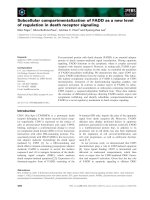
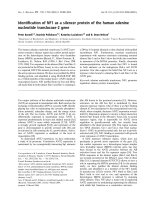
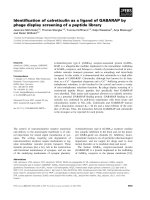
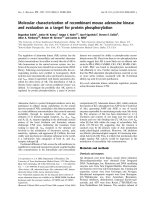
![Báo cáo khoa học: Properties and significance of apoFNR as a second form of air-inactivated [4Fe-4S]ÆFNR of Escherichia coli pot](https://media.store123doc.com/images/document/14/rc/at/medium_ata1395562826.jpg)
